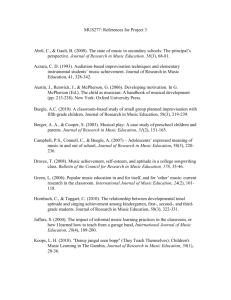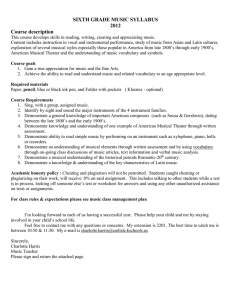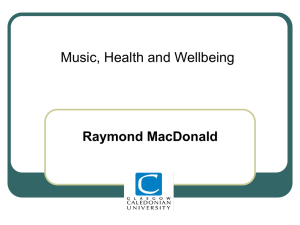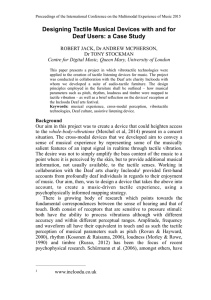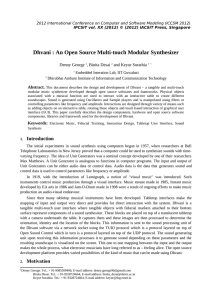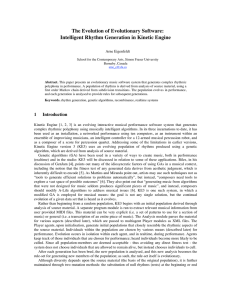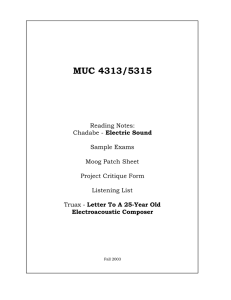Singing the Body Electric: Improvised performance and
advertisement
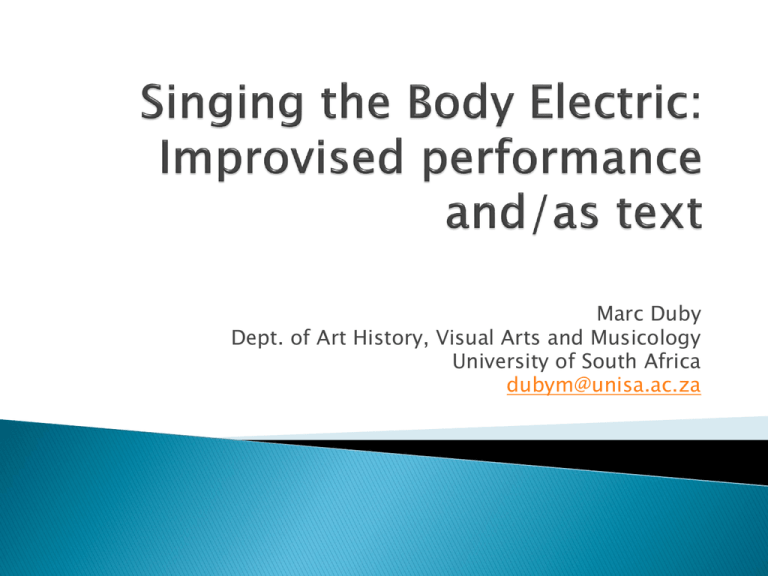
Marc Duby Dept. of Art History, Visual Arts and Musicology University of South Africa dubym@unisa.ac.za Free improvising ensemble in 1990s Johannesburg, consisting of Bruce Cassidy: leader, trumpet, EVI Rashid Lanie, David Hoenigsberg, Marc Duby: synthesizers Rob Watson: drums Mostly spontaneous music with some notated elements based on Hindu mantras Performed concerts at the University of the Witwatersrand To consider what perspectives might enhance (or not) our understanding of two instances of the band’s freely improvised material: 1) The original concert 2) The YouTube version Body Electric at Bozzoli 1994 “The history of reflection on the nature and value of music is a game of hide and seek: hide the body and its materiality, its subjectivity, its temporality, and its specificity; then seek compensatory value in characteristics deemed durable, objective, and trustworthy ― the formal, the structural, the ideal.” Bowman and Powell (2007:1087) Unlike typical jazz, free improvisation tends to eschew “the structural,” and may only flirt with ideas of structure and form It follows that there can be no “…compensatory value in characteristics deemed durable, objective, and trustworthy.” Rather, the musical conversation is fluid, capricious, playful, kaleidoscopic, and the persons (musicians and audience) involved focus on “micro-processes of interaction” (R. Keith Sawyer) Insider’s perspective (“How did I experience this event?”) Real-time, fluid Embodied, tactile experience Collaborative, co-creative (in the moment) “The challenge facing the human science researcher is to describe things in themselves, to permit what is before one to enter consciousness and be understood in its meanings and essences in the light of intuition and self-reflection.” Clark Moustakas Focus on one’s perception of the unfolding event Create the music as it happens Keep it open; use the “Yes, and…” gambit Musical relationships understood as shifting lines of force Playing instruments: touch, then sound Muscle memory: habit (acquired understanding of “where things are”) Merleau-Ponty 1962 167ff: discussion of organist’s performance “…Habit has its abode neither in thought nor in the objective body, but in the body as mediator of a world.” I consciously chose to play analogue synthesizer, not my more customary acoustic or electric bass: to subvert/circumvent this habitual framework Work together to create the musical event Not exhibit technique for its own sake Listen carefully as things unfold Avoid competition so as to favour conversation: “let the music speak” “Prosthetic technologies are materials that extend what the body can do ― for example, steam shovels, stilts, microscopes or amplification systems enhance and transform the capacities of arms, legs, eyes and voices. Through the creation and use of such technologies actors (bodies) are enabled and empowered, their capacities are enhanced.” Tia DeNora: “Music in Everyday Life” Invented by Nyle Steiner, the EVI is an electronic wind controller which generates MIDI data such as pitch, volume, vibrato, and so on. Designed to be connected to a synthesizer for sound production, it is capable of producing a theoretically infinite variety of timbres and has a far wider range of available notes than its acoustic counterpart Outsider’s perspective Once a given performance is recorded, theory has it that it takes on the status of a “text” Susceptible to analysis, located in the public domain, objectified/reified Musical and social interactions as seen from the film-maker’s perspective More participative for the viewer (change volume, change the channel, turn it off, etc.) ― illusory freedom of choice I Sing The Body Electric: Walt Whitman 1855 I Sing The Body Electric: Ray Bradbury 1969 Weather Report 2nd album 1972: like the Body Electric, also featuring electronics, free improvisation, and sense of the spatial Notions of intertextuality tempt us to make these links, but emphatically denied by BC (Skype interview June 2011) From a performer’s perspective, I tend to treat with caution this particular event’s elevation to textual status, as reduced to two dimensions of sight and sound, digitised, flattened out. Posted on YouTube for public access, the video clip may serve to remind us of the unrepeatable immediacy of the original performance, “through the wrong end of the telescope of time.” “The paradox of contemporary times is our belief that technology can restore for us lost immediacy: lost because we live in a complex and separated community. It seems to us that modern technology ― air travel, the phone, the electronic chatroom* ― is able to bring us back together. But we never had the full community we think we lost. We were always at a kind of distance (geographical, emotional, political, generational, cognitive) from each other. And we never accomplish the instantaneity we think is promised by new technologies.” Penelope Deutscher 2005:63 (* or the Internet) Trusting in what it felt like at the time and depending on the mysterious processes of memory, nostalgia, the evidence of the tactile and auditory, ethnography (conversations with ensemble and audience members): is this not perhaps how we might “make history”? At a unique moment in history, on the eve of the first democratic elections in South Africa, a group of musicians created a specific series of musical events in a particular space. This quasi-ritual, as it unfolded, had the effect of creating a temporary sense of community between players and audience: In sum, a glimpse of the fragile wonder of what it is to be human, and alive. IASPM Unisa This work is based upon research supported by the National Research Foundation and any opinion, findings and conclusions or recommendations expressed in this material are those of the author and therefore the NRF do not accept any liability in regard thereto.


